Last updated on 04/11/2016
Updated below with info from Marie Vitulli (Math Emerita).
The 2015-16 AAUP salary survey is now out, and I’ve posted it below after the 2014-15 IPEDS data from the Chronicle. These data are self-reported by universities to the DoE or the AAUP, and not always accurately or consistently across universities. The definitions also vary across the two surveys, as do the comparison groups they provide.
I was surprised to see that the gender gap at UO shrinks with faculty rank both in dollars and percentages, and almost disappears in the AAUP data. In contrast, for both sets of comparison universities the gap is pretty constant in percentages.
I wondered how much the gender gap varies across departments. For UO, you can get average pay by department and rank (but not gender) for 2014-15 from Institutional Research here. Or you can really drill down in the individual salaries – Feb 2016 is here. (When I looked for my department, I found some large errors in the IR summary data.) IR has also posted a “Faculty Equity & Inclusion Report” here, but it does not have any salary data. How odd.
For 2014-15, from the Chronicle (IPEDS):
For 2015-16, from the AAUP:
UO’s AAUP numbers are basically unchanged from last year, because during bargaining the administration insisted on delaying the raises until after the survey due date. Marie Vitulli (Math Emerita) has sent in this, comparing UO to our 8 AAU comparators. There is more on her website here.
By gender:
Overall, we’re dead last in pay, except we edge out Iowa for assistants. Because they know Uncle Bernie will ask, the AAUP also reports total compensation numbers, i.e. pay plus benefits. The ratio of benefits to salary for UO is higher than average, although the AAUP is careful to point out that total compensation measures the cost of benefits to the institution, not the value of the benefits to the faculty. I’m not getting a lot of benefit from Mike Bellotti’s $500K PERS deal, but it’s sure costing UO and other state employers a lot. For health insurance, UO pays the same rate as all state employers, even though UO workers are healthier than average.
And for a comparison, overall in 2013-14:
I don’t know why the salary numbers UO reports to the feds are so different from the numbers they report to the AAUP. Note that the AAU also uses a very different comparison group: public universities that grant a certain numbers of doctoral degrees. PSU, for example, is in the AAUP comparator group but not the Chronicle one. (The data on instructor/lecturer/NTTF/contingent pay is not very comprehensive, so I’ve omitted it.)
For non-academic employees, the Chronicle reports that average UO pay for those classified as Management for 2014-15 was $124,406 vs. $114,465 for all VHR universities. UO pay for Office/admin support was $41,417 vs. the VHR average of $44,090. I don’t think these cross-university comparisons are very reliable because of differences n the definitions, but the time trends for UO should be, and the pay increases for Management at UO have been remarkable:
2012-13:
2013-14:
2014-15:
Faculty pay by rank, gender time-trends 2004-2014 (2014 means the 2014-15 AY):
UO full professors (orange) v. VHR (green): 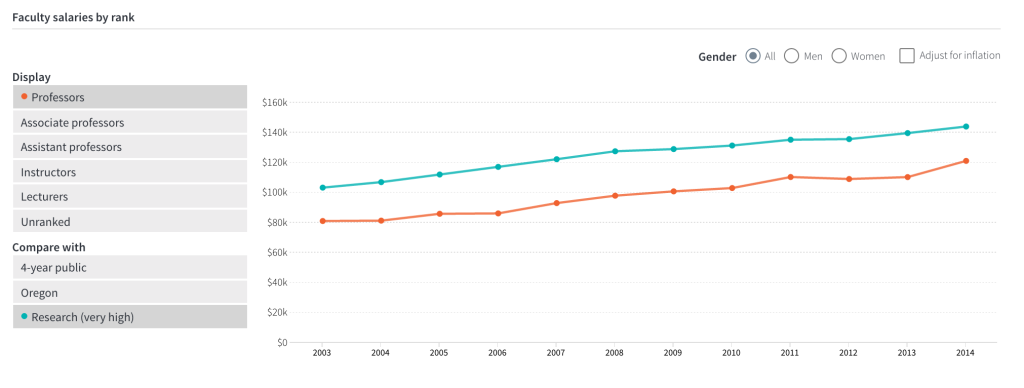
UO associate professors (orange) v. VHR (green):
UO assistant professors (orange) v. VHR (green): 
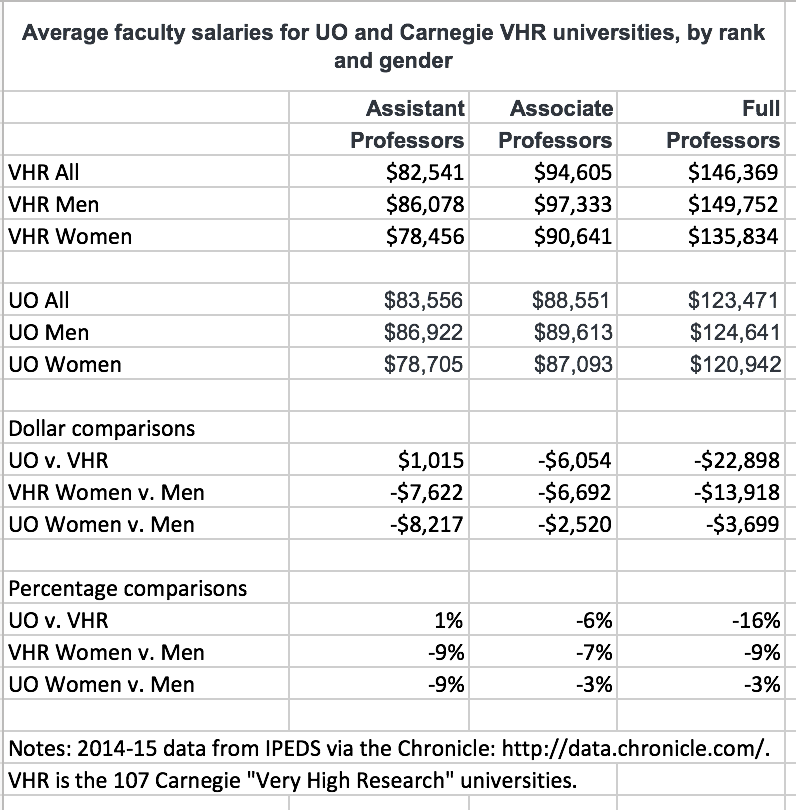
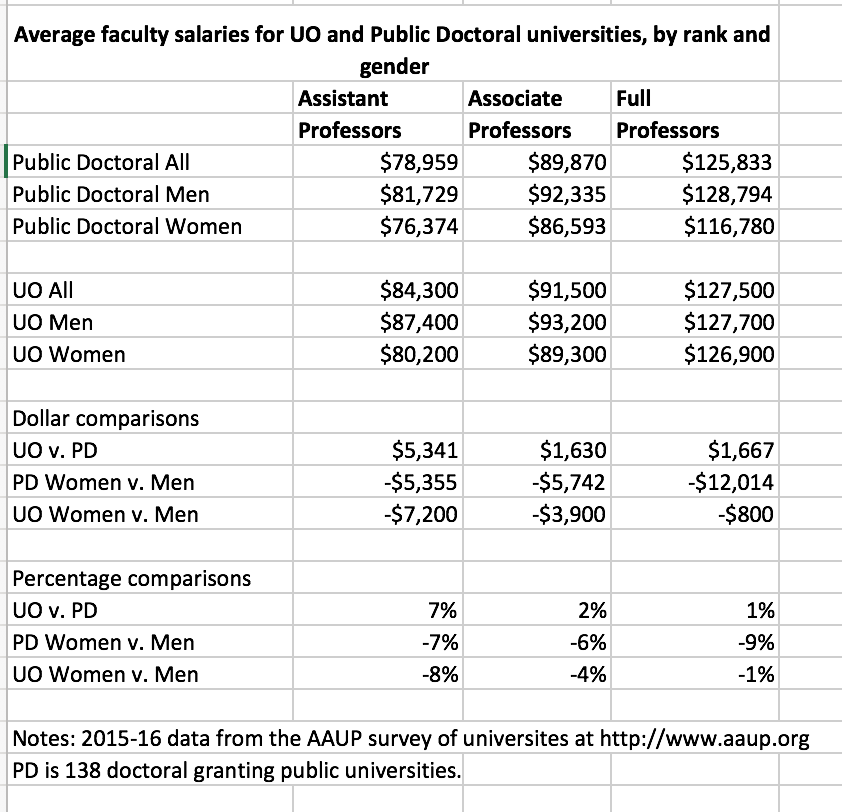
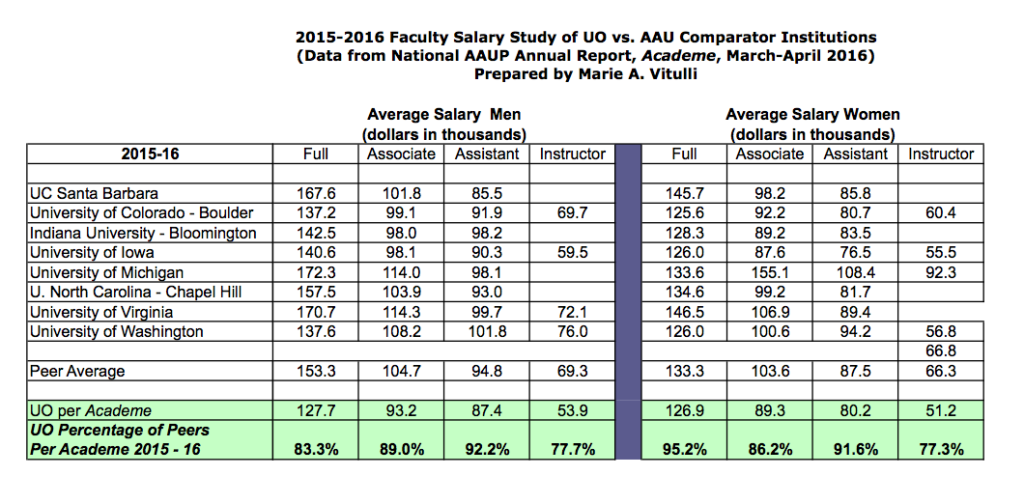
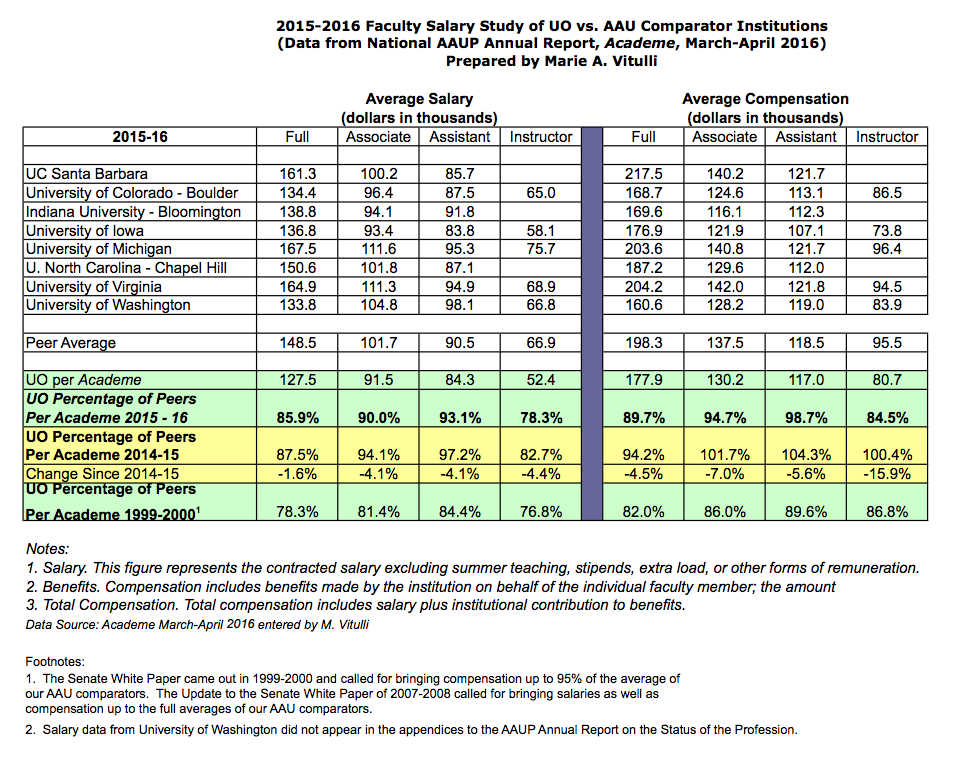
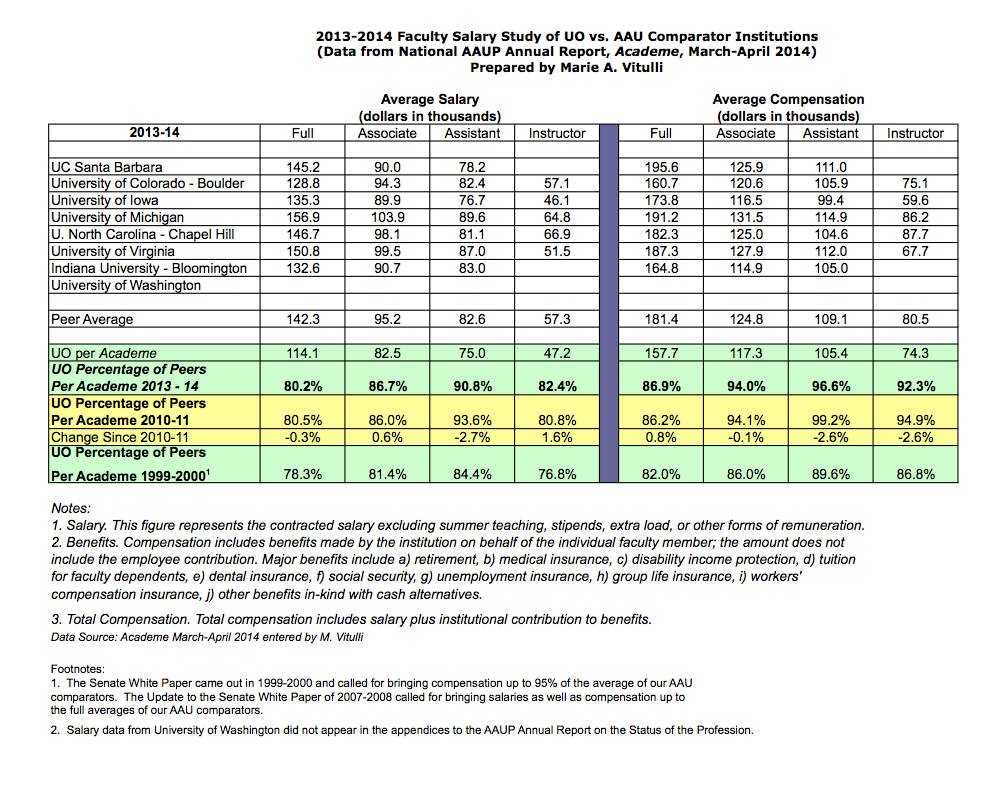



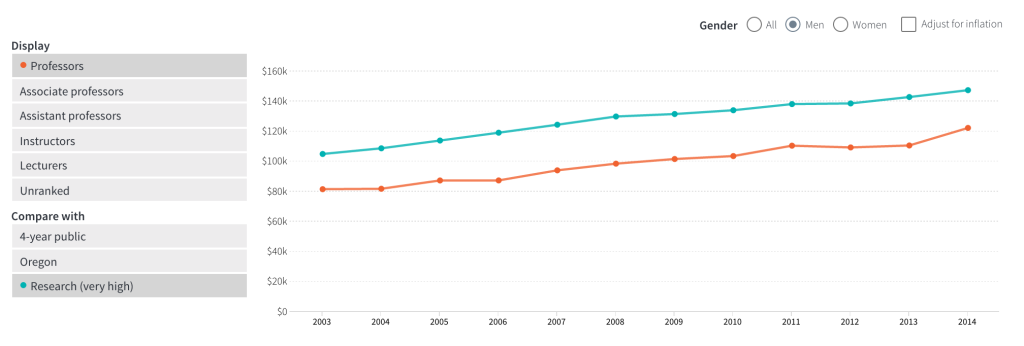
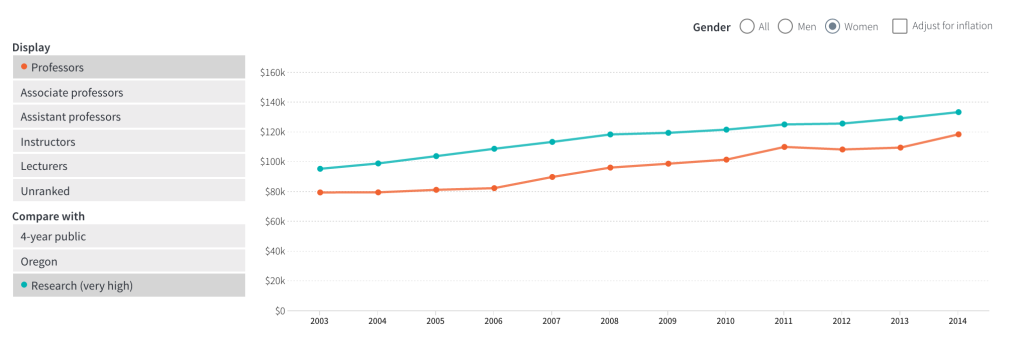
Thanks UOmatters
good work
of course none of this is surprising and for the full professor graph I think it shows the important point that the lag has been nearly constant over the last 15 years, despite perceived gains in Salary ….
At the Assist professor level we have to be competitive so as to actually hire people – this exacerbates the well known salary compression problem at the UO
Is there lag? Full professor pay is 74 out of 107. What would be an appropriate position for UO in this list of Very High Research Universities?
My take-away is that admin is overpaid — 45 out of 107 when the UO has relatively small units compared to bigger universities. Glad to see not much salary difference between men and women at the full professor level.
Just a bit higher than us on the list is UW and CU-Boulder. Should we be higher than them? The housing costs scores are twice as high in those places.
Faculty may think they deserve higher salaries, but this list is not a strong reason on its own.
I am sure there is a lag as the UO is reactionary – that indeed was the basis for the 2011 CAS (and other unit) raises.
Personally I am not all that concerned about my salary in the absolute sense – I get paid reasonably well and as a University professor I don’t really need to do anything so …. there you go
What does bother me is our consistent inability to catch up with any comparator sample we come up with.
It is maybe a little non-aspirational to say our comparator set is the smaller, lower-reputation schools of the research active universities, but it is perhaps the most apt. I think we would look OK in that set.
your asking for realism at the UO? …?
“Not much salary difference between men and women at the full professor level”? In my department the difference between the average for men at that level and the average for women at that level is around $6000 per year, which looks to be about average for the university. I guess that’s “not much difference” if it’s in your favor. And maybe if you’re coming in at around $120,000, you can afford to say “Oh sure, let the guys have some extra thousands, I don’t mind.” When you’re making $77,000 as a full professor, seeing the guy in the next office making an extra $6000 for no discernable extra accomplishments sticks in the craw. As do people who are dimissive about it.
$6000 is a lot. I was trying to see the graphs, and thought it was 1 or maybe 2 thousand, and then looked at the AAUP chart which said $127,700 for men compared to $126,900 for women, which was the basis for my comment. If the chart had supported your overall $6000 difference I hope I would not have reacted the same way. I thought the difference of $800 could be explained by lower ratios of women in the oldest (and presumably highest paid) faculty… but I admit I don’t know.
Somewhere there are some departments where women are well- and equally paid — I wish they were at the UO and near me. In my department the top-paid male prof makes $20,000 a year more than the top-paid female prof, and $30,000 more than the second-top-paid female prof. Indeed the profs in the top 25% of salary are 90% men. Correlates with years at rank? Nope. Correlates with CV? Not that I can see. It always baffles me how these charts and averages never seem to reflect reality on the ground as I observe it. Well, glad to know the averages are working out somewhere. Doesn’t do much for morale over here though.
I know, I was very surprised to see these results too. Where is that mysterious department where everything is flipped?
The union is looking into gender equity and external equity, and I think UO has hired a consulting firm. I’ll post more if I learn more.
I can think of one dept in the sciences where there is a female full professor that makes $50-100k more than the other full professors, and there are not many women in the department, so that whole department could look “flipped” even if it is mostly an outlier effect. She could raise the average for female full professors campus-wide by $100s alone!
Are we going to measure equity in all of its forms? For instance the likelihood that a spouse gets a subsidized position at the university? Is that included in equity?
Are we going to measure the extent to which differences in pay across gender are driven by outside offers/retention raises or differential attrition rates? Do they get the same counter-offers? Do they exit at similar rates?
Or are we going to focus on just whether men and women get the same salaries?
Re: the difference between IPEDS and AAUP.
IPEDS collects data on full time instructional staff only (i.e. any faculty whose job description includes some instructional duties, not just those who are 100% teaching), while AAUP data includes full time and part time instructional, research, and service faculty. Neither survey includes medical school salaries.
I like these graphs and for my next statement am I defending gender wage differnce, however I cant help but want to remove some of the variables.
Each person is different and the closest I could hope for is a direct comparison job for job. Is there more people of one gender in a particular area (like math or marine biology) verses another? what is the split in these departments? Are these positions being compared bachelors to doctorates?
I know in the position my friend has at the UO the wage can vary widely based on qualifications.
I think if they are comparing full professor to full professor the qualifications will be pretty similar.
So UO managers averaged 33% raises while office staff averaged 6% raises over two years. I guess that’s what Schill means by budget realignment.
This is a real problem.
These OA and staff numbers predate Schill. That said I’m guessing the trends will continue.
Looking at our AAU comparators our salaries (and total compensation) the UO is dead last in the list. The overall comparison is posted here. http://pages.uoregon.edu/vitulli/SalaryStudy2016.pdf
Thanks for the real data
Some comments
1. As others have argued, this is likely not the proper comparison
institutions, but if it is, ADMIN – then fucking do something about it (quota used)
2. We fell by 1.6% in the last year and are likely to fall further due to the only raise being 2% given on Jan 1 2016 for the last 18 months
3. Isn’t it clear by now that we are no in the same league as the AAU comparators? -Yeah we could be with a large investment in
facilities, more faculty, and more competitive salaries. Oh yeah, that track meet in 2021 will cover it all …
I remember the top administration of UO, including the VPFA complaining about any salary increases for faculty. Coltrane proposed a big 0 for faculty last spring year. How do top administrators think any of their lofty promises for the UO will work with this blatant disrespect to faculty and failure to budget for serious investment in faculty?
Let’s see, faculty remuneration is going backwards compared to any decent set of comparator institutions. Same for the pay of OAs, classified staff and GTFs. Only group that has seen a pay raise against the same comparators have been our administrators and in particular the upper echelon, i.e., Johnson Hall and Deans’ offices. Plus a massive increase in numbers of mid-level administrators, nearly all of whom take home more than most faculty and certainly much more than other university employees. This is not a new trend – it started in 1990 with Ballot Measure 5 and has continued unabated for 25+ yrs. Every couple of years we hear the same refrain – “we are going to pay you more” followed by “well, we would like to pay you more but [fill in the blank]” e.g., declining state allocation, current budget crisis, tuition too low, too few out-of-state students, resources previously allocated elsewhere etc. However funds are ALWAYS found to increase administrators’ salaries, perks and office staff as well as pet projects. Our new Board of Trustees talk a good game but in the end have done nothing. The faculty union, for all their promises, have sadly had little positive effect either on salaries or academic quality. Ditto for the Senate which was never very strong but was certainly stronger than the current version, which bends to nearly every administrative initiative. I don’t see any of these groups taking any initiative to improve our quality or raise salaries to comparator levels despite their annual promises. It is therefore left to the employees of this once fine university to save it from disaster. What to do? 1) Insist that students comes first in all decisions at the departmental, College/School and University levels; 2) Stop accepting all administrative initiatives as done deals; fight the ones that go against our values e.g., UO Police Dept shenanigans, the EMU renovation debacle, the cluster hires at the expense of people’s jobs, the yearly complaint that UO does not have sufficient funds to fund X, Y or Z depts, cuts in staff and GTFs, sweeping athletic dept scandals under the rug etc; 3) Insist that the Senate and Faculty Union put all their focus on academic quality issues (salaries IS an academic quality issue); 4) Talk to colleagues outside your dept and school to learn about their issues in order to avoid faculty in-fighting (the administration’s best friend); and 5) Give others on campus the benefit of the doubt. Everyone is working incredibly hard to stay afloat. Stop whinging and start showing respect across campus. If we actually trust each other, we will work together to improve this place. The alternative? Well, you are seeing it happen in real time and it ain’t pretty.
“The faculty union, for all their promises, have sadly had little positive effect either on salaries or academic quality.”
You and I have been reading different pay stubs, Sun Tzu. And yes, I’m a tenured full professor. The difference between faculty compensation in 2012 and 2016 is enormous.
I too know how to look at pay stubs
the max difference its between October 2012 and October 2014 (or perhaps April 2011 and October 2014 as that includes the significant equity raise)
Compare your paycheck now to October 2014 – unless your special
its only 2% higher,
Okay, I calculated the percentage increase of my paycheck from October 2014 to now. Yep! 1.9%! Someone probably got those big raises — haven’t seen them in my paycheck.
yes and that 1.9% will be the same until next January unless your
subject to a non-standard raise.
Perceptions of the impact of the Union vary all over the place – its always good to ground those perceptions in numerical reality over some appropriate time span.
The UO, instead of adding another % to our base this year would only budge with a one-time cash payment, which the union negotiated up to $650. So the UO might have moved us closer instead of further from our comparators if they had listened to the wisdom of union negotiators. But everyone did get a one time prorated payment too. As for you comment Anony, I think Polyanna was referring to the cumulative increase in pay since the 2012 (see comment from michael below). And I suppose you are with Sun Tzu in thinking we would somehow be better off if we didn’t get the union negotiated average of ~13% over the last 3 years? And the future raises too?
My salary has now increased by 24% since 2012. That includes an 8% review raise. My colleagues got similar raises except for one dead tree. Still well below faculty I know at other universities, but a big improvement. It’s hard not to give the union some credit. Damn I hate admitting that.
I have a card I’d like you to sign.
I am not counting the 8% PTR thing at all – I agree that is very generous (and serves to cause internal equity problems in
depts – which of course should even out over 6 years) but yes
15-16% since 2012 is about normal and, as the data has shown
previously, that has not closed the full prof gap at all …
Since the first union contract in 2012, every faculty member at UO has received raises and will continue to receive raises, averaging (without promotion raises) about 20% over 5 years. Tell me the union has not made a difference and I have bridge to sell you. And this has been done at a time when the UO administration has clamored incessantly and relentlessly that the well is dry (and after massive decline in state support, 2009-2013). As we speak, our union is building a case for external and internal equity money in the years ahead. Just because other top-notch AAU campuses appear to have offered bigger raises this year does not mean they they will match or exceed our 3% (plus promotions) next year and the year after. There is clearly a need to do more, which is why I see a good case for getting involved in our union and help assure that we get to 95%-100% mean of our comparators in our next contract. Sitting back and complaining that ‘the unon’ did not get enough this year will do what?
seems to me the entire point of this mini-controversy is simple
Yes the union has apparently made a difference
At the full prof level, the pay gap has been maintained despite this difference. I don’t think anyone is blaming the union for that. I think they are reinforcing that this persistent gap exists. As a consequence, the probability of achieving “more” is low, in my view.